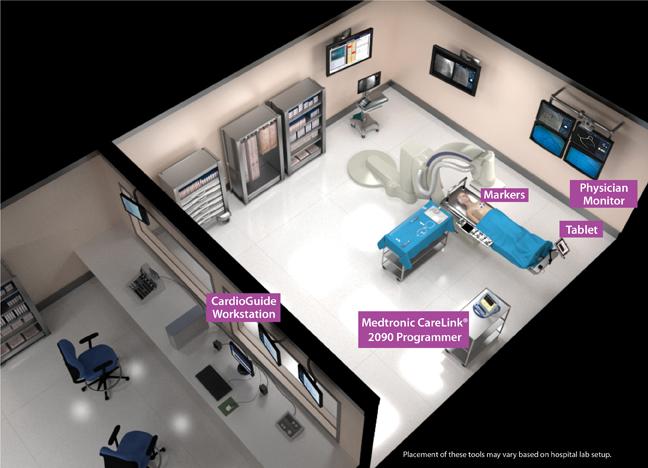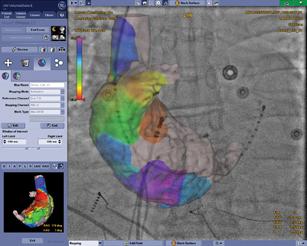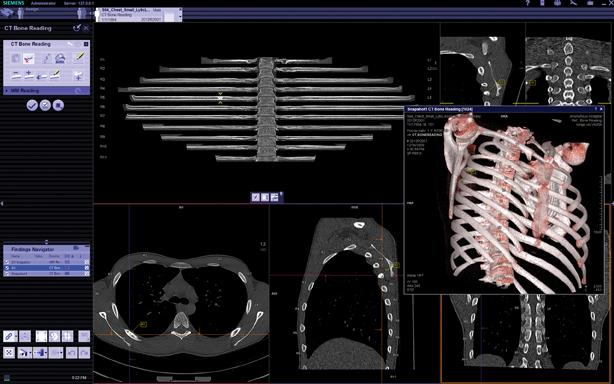
GE Healthcare said its CardiacVX for rapid reviewing and reporting addresses the clinical demand for more automated and user-friendly post-processing.
When physicians began utilizing advanced visualization, the software was limited to academic institutions and large hospitals. It was part of a dedicated workstation with dedicated hardware, making the technology a standalone application that was not typically utilized beyond the walls of the department where the workstation was located. Physicians would retrieve digital imaging and communications in medicine (DICOM) images from a modality and then work on the images at the workstation.
Advanced visualization software has since seen major advancements due, in part, to the need of other physicians to view these images — an act that became increasingly difficult using picture archive and communication systems (PACS) alone. As technology continues to improve, advancements have propelled the software outside of the area of academia and research to more routine use.
From Thick to Thin Client
One of the major advances in advanced visualization has been the move from a thick client to a thin client and cloud technology. Ten years ago, when everything was done at the workstation located in the department, it was difficult for other physicians to access these images for surgeries or therapies. They would either have to go to the radiology department or rely on the paper report.
Today, more physicians are utilizing the hospital or imaging center’s server to store images so that any physician with secure access to the server can view and manipulate them. With the introduction of Web-based services, many physicians have gone further, choosing to utilize cloud technology. This allows hospitals and other networks to store large volumes of data over the Internet, often via a Web-accessible, third-party hosted cloud server.
The switch from the workstation (thick client) to server-based (thin client) and cloud-based storing has led a majority of companies to offer thin client advanced visualization options, and a few are beginning to offer cloud- and Web-based software. Fovia, Vital Images, TeraRecon and Siemens Healthcare are a few that already offer these types of options, and this is a practice that Henri “Rik” Primo, director of strategic relationships, syngo Americas, Siemens Healthcare, sees continuing well into the future. “At some point in time, most of these applications will be running in the cloud,” he said.
Introduction of Intuitive Workflow Features
An important benefit that advanced visualization software has been able to offer is the ability to streamline radiology workflow. In addition to increasing the speed by which other physicians are able to access and view images, Primo explained that before recent advancements, a specialized technologist would pre-prepare the slices so that the radiologist could see the reconstructed 3-D image set and not have to spend time removing things like the bone structure or annotating spine segments. Stephen Bravo, M.D., diagnostic radiologist, co-founder of Sand Lake Imaging in Orlando, Fla., explained how difficult this process was when the center first started in 2005. “When we updated to a 64-slice computed tomography (CT) scanner, it made the acquisition of the images much easier, and therefore the manipulation of the data a little bit easier, but still the processing time for the technologist took anywhere from 45 minutes to an hour and a half, depending on the quality of the data acquired,” he said. Now, algorithms are becoming available to do a lot of the pre-processing and post-processing automatically, further simplifying radiology workflow. “With the integration of syngo.via there was turnaround in the processing time that dropped from 45 to 90 minutes to 15 to 20 minutes, maximum.”
As the software continues to evolve, manufacturers are finding additional ways to make it more user-friendly and intuitive to help further streamline the radiology process and promote widespread adoption. For example, Claron Technology introduced its Withinsight Framework (WIF) version 2.1 with five new sample applications that show users how to optimally use new software functions. Similarly, GE Healthcare said that its CardiacVX for rapid reviewing and reporting was designed to address clinical demands for more automated and user-friendly post-processing. Matthew Hayes, technical director, Cross Sectional Imaging, Sand Lake Imaging, spoke about the ease of use Siemens’ syngo.via software, which has led to faster turnaround times. “Within the eight IVP (intravenous pyelogram) delay on a CT, our technologist has already been able to complete 75 percent of a CTA heart, maybe even the entire thing. This keeps our report time down and positively impacts our patient care,” he said.
Primo said that continued simplification would be the next step to further improve acceptance of the technology in the normal clinical routine workflow, and could help reduce training time.
Advanced Vis for Surgical Planning and Guidance
As more physicians begin to utilize advanced visualization software, there has been a natural progression to find other uses for the images outside of diagnostics. According to Primo, “As more doctors and specialists are becoming familiar with 3-D presentation of images, you see that they want to do the reconstructions themselves.”
Primo explained that for certain surgeries — neurosurgery, for example — precision and accuracy is of utmost importance. “You want to make sure that you navigate very carefully,” he explained. While surgeons used to rely on radiologist’s data sets for the location of the tumor, today surgeons are beginning to construct their own images using advanced visualization to plan the trajectory of needle-based interventions. EOS Imaging recently received U.S. Food and Drug Administration (FDA) clearance for its sterEOS 3-D software, which automatically calculates clinical parameters for surgical planning.
Surgeons are also using advanced visualization to navigate surgeries in the operating room (OR). Medtronic’s CardioGuide Implant System utilizes 3-D imaging to project a roadmap and targeted placement of the pacemaker onto an overlay of the patient’s heart. The system also tracks the real-time location of electrodes, allowing physicians to confirm that the lead is placed in the correct location. GE Healthcare’s Innova EPVision 2.0 also provides live visualization of patients’ anatomy and associated devices to aid physicians during procedures.
Advanced Visualization of the Future
From a clinical perspective, advanced visualization software is gearing toward the use of multimodality 3-D and fusion. Multimodality fusion involves the ability to work with multiple modalities — CT, magnetic resonance imaging (MRI), positron emission tomography (PET) and so on — at the same time, in order to gain a holistic overview of a patient’s condition. Bravo has utilized Siemens’ syngo.via advanced visualization software in his research. “Advanced visualization has been exceedingly important for that because we are correlating modalities — CTs, MRs and PET bone scans — in an attempt to be as accurate, sensitive and specific as possible for lymphatic and bone metastatic disease,” he said.
Primo predicted that fusion will continue to expand within all of the modalities and specialties. According to Primo, Siemens has focused on multimodality routine readings — starting with CT, going into MR and PET and eventually making its way into computed radiography (CR), digital radiography (DR), angiography, and fluoroscopy with CT reconstruction based on fluoroscopy views. TomTec Imaging Systems also received FDA clearance for its Image-Com software solution, which offers multimodality, multidimensional and multivendor image review, in November 2012.
Technological advances also will have major impacts on advanced visualization software and its use within medical care. “We all know Moore’s law, and we know that more and more processing power and gigabytes can be packed into chips. So that means we can expect the performance to double or triple every year,” said Primo. He cited that current technological obstacles, such as bandwidth and performance limitations, would decrease because of the speed of development in capacity and capabilities. With these obstacles eliminated, the options for the utilization of advanced visualization in healthcare are exciting. Bravo noted that advanced visualization software will continue to play an increasingly important role in the area of Alzheimer’s and dementia research as the economic toll of these diseases continues to grow, which will necessitate finding better ways to treat these diseases.





 April 23, 2024
April 23, 2024 








